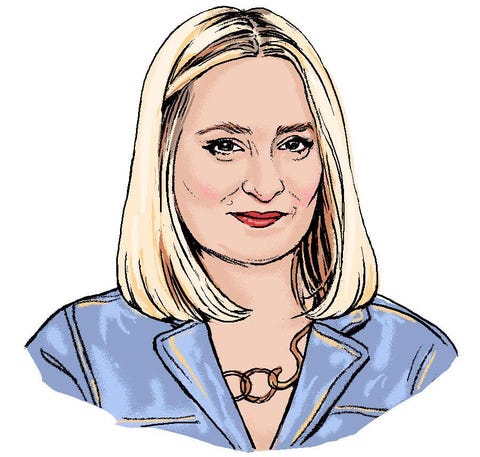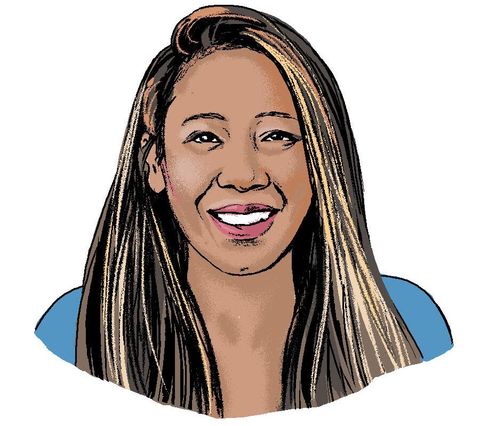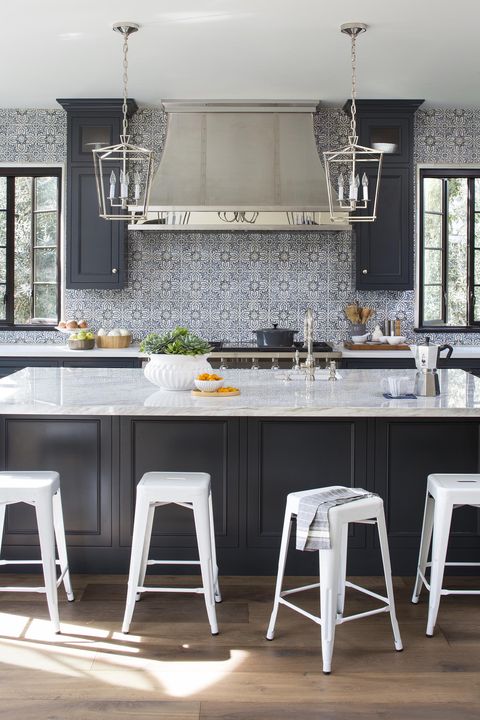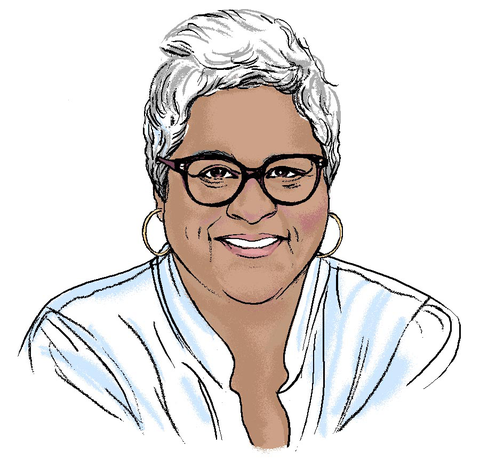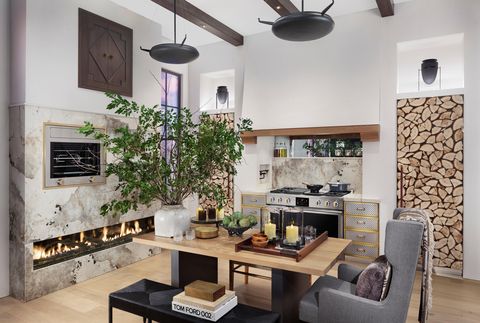Kitchen Designers Discuss Trends and Predictions for 2022 and Beyond
Editorial Director Joanna Saltz spoke with four experts about the fads they’re seeing come and go, the ones they can’t quit, and what’s next in kitchen design. Ahead, dive into the major trends and predictions kitchen designers Caren Rideau, Lauren Lothrop Caron, Linda Hayslett, and Richard T. Anuszkiewicz are seeing right now, and then scroll down to read the whole fascinating conversation.
What’s In:
- Comfortable, English kitchens that feel lived-in
- Colorful kitchens
- Clever storage solutions
What’s Out:
- Perfect countertops
- Extra small appliances (Do you really need that air fryer?)
- Paying more for appliances with 20 different presets that you won’t use
What’s on the Horizon:
- Treating the kitchen like a living room
- Dining chairs as seating (perhaps dining tables to replace kitchen islands)
- A mix of materials
- Less cabinetry
Joanna Saltz: I have an allergy to the word trends. There’s something about it that sounds so fleeting and annoying. Much of what you as designers try to cultivate in the world is a real sense of longevity, and you never want anything to feel old after any amount of time. That said, there is a lot of talk about what’s new and what’s happening. It’s like taking the emotional and physical temperature of culture, and seeing how that informs design. So, what are your kitchen design clients asking for in this exact moment in time?
Lauren Lothrop Caron: They all want a kitchen that looks like it came out of the English countryside, because it’s more comfortable. It doesn’t feel like everything’s brand new. It has inset cabinets. It’s warm, it’s inviting, and it’s a bit moodier in the terms of the color palette, not super white and bright.

Jo: It’s approachable. It’s like you’re living in your kitchen, which people are doing now.
Caren Rideau: People are comfortable asking for color. I’ve been using color in kitchens for so long, and I’m glad to see it being spread out more.
Linda Hayslett: The word approachable really nails it. Being in L.A., my clients are asking for a contemporary-modern style—but a version where they don’t have to freak out over things.
Richard T. Anuszkiewicz: Livability and usability, especially good storage solutions, are big. Many of my clients say, “I want to use this space, but I also want to be able to tuck everything away so it looks semi–put together if I have someone come over.” There’s also this idea of personalization. The power of the market today is that it’s open-ended, there are so many relevant aesthetics and finishes. What’s important is finding the soul of the kitchen.
Jo: What do you wish clients would ask for more? Is there anything you try to sneak in?
Linda: I snuck a small shelf for spices into my client’s kitchen. You normally see them over the stove, but I put shelves on the sides and all around the kitchen. Initially, the client was unsure. Now she’s like, This is amazing. Everything fits. I can put my iPad on it, and it’s high up, so I can read while I’m cooking.
Caren: Everybody has different cooking needs. Some people bake. Some people roll pasta. Some people want a place for their kids. Every function is a lifestyle choice for that individual. What you do for one client isn’t necessarily the high point for the other. It’s not cookie-cutter.
Lauren: I always try to add a second sink. My brother is a personal chef, and he tells me you have to have two sinks in every kitchen. We’ll put it near a beverage fridge and say it’s the zone for kids or anybody coming in the back door by the mudroom, so they stay away from you while you’re cooking. If there’s room for a pantry that can become a scullery, then we like will put a sink in there to separate them.
Richard: I’m always looking to expand the space—it’s a philosophical approach that I try to instill in my clients about seeing the room in an architectural way. I’m not solely looking at this kitchen. I’m looking at the neighboring rooms and thinking about the positive and negative spaces. I’m also always looking to expand the space, so that’s probably my workaround or wish for clients.
Jo: What do you wish people would stop asking for?
Richard: That’s hard. I’m fortunate to have carved this niche in kitchens specifically where a lot of my clients are like, We know you got this. They’re down for the ride. So there isn’t an immediate thing that comes to mind, or maybe it goes in one ear and out the other. I always say my goal is to be the chameleon to the client, where I take their raw energy and ideas and enhance it in every which way imaginable. Often, that could be leading them down a path they never thought of or couldn’t have ever imagined, but I feel like that’s what they’ve hired us to do.
Caren: It’s funny because, as Richard’s talking, I’m thinking there are so many times I walk into the kitchen and someone will say, “I want this here, this here, and this here.” And you hear it, but you don’t because you know that’s not what it’s gonna end up being. Clients have to grow with the process. In the end, they understand why this goes here and why this doesn’t go there. But I do think people get attached to the island. It really serves a purpose. In smaller spaces, sometimes it doesn’t work.
Jo: I hear you. You wish clients would stop having such preconceived notions as to how every kitchen is supposed to flow.
Lauren: I wish clients would stop obsessing over perfect countertops. Corian or quartz is never going to be marble or feel as authentic. Nobody thinks about ceramic tile aging. Let’s stop focusing on how marble can chip or stain.
Linda: With appliances, I wish they would just pare it back. There are a lot of bells and whistles. Are you really going to use those 20 different presets? You don’t need to pay extra for some of these things.
Lauren: A big pet peeve of mine is all the extra small appliances people get, the air fryer and the whatevers. Why not spend more money on a range that has a convection oven than having an air fryer that’s going to take up space?
Jo: I definitely think we’re in that place of “more is more.”
Caren: The U.S. is very appliance driven. We think the bigger, the better. I have to tell my clients, “Let’s make sure you really are going to use this appliance and not just put it in, because square footage is valuable.”
Jo: How about the pot filler? Yay or nay?
Caren: I’m not opposed to it. I have a very small kitchen. It doesn’t have an island, so I would have to walk five steps to fill a pot. I do make soups. I make beans. So it comes in handy. But a pot filler is not a decoration. It’s a function. If you don’t cook like that, don’t put it in. If it becomes useful to you, then put it in.
Linda: I’m for pot fillers if it makes sense, moreso with smaller kitchens. I do like to put in two sinks, but if you can’t, then it helps out to do that for functionality.
Lauren: I don’t think they’re necessary, but I kind of consider them as jewelry. If you’re going to spend a thousand dollars plus the cost of plumbing and the time it takes to map out the placement of the pot filler, and there’s something else that’s more important and maybe it’s not super necessary, then I would nix the pot filler. But if the budget’s there and it makes sense functionally, then I love a pot filler.
Richard: I’m into a pot filler, but I try to show people different ideas. In the front of my showroom, I put a pot filler in the niche on the side, so it doesn’t have to be right above the cooktop. It can be done in different ways, but it provides a function. If you pick the right one, it can be a little extra jewelry.
Jo: Since we are talking about trends, what’s next?
Richard: The kitchen has evolved to a way more dynamic space than strictly a food cooking and prep area. It is a living room. Engaging natural light and the material mix are super important. Is there comfortable seating? Are there textures that make you want to hang out there?
Caren: Not every part of the kitchen needs to be filled up with cabinets. You also don’t have to have a white kitchen or a blue kitchen. You can mix materials. You can use wood with two different painted colors.
Lauren: When everybody went away from white kitchens, it was green because it was more comfortable. Now, I’m seeing more paprika and turmeric, almost like spice colors, but then you also have clients who want aubergine.
Linda: I think there is going to be a new revelation with islands and how they’re used. I did one recently that has actual dining chairs and a unique shape.
WANT TO TALK? E-MAIL ME AT EDITOR@HOUSEBEAUTIFUL.COM.

